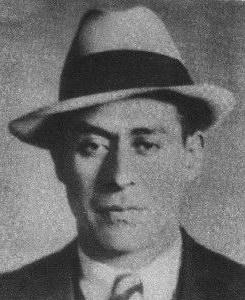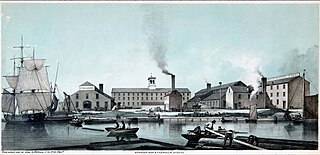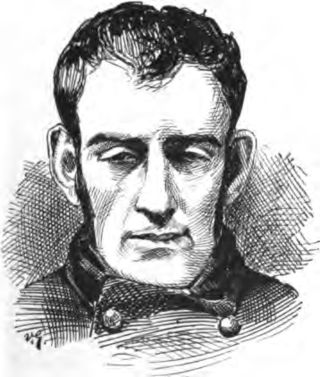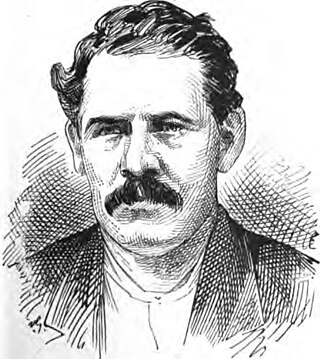
Joseph Theodore Leslie "Squizzy" Taylor was an Australian gangster from Melbourne. He appeared repeatedly and sometimes prominently in Melbourne news media because of suspicions, formal accusations and some convictions related to a 1919 gang war, to his absconding from bail and hiding from the police in 1921–22, and to his involvement in a robbery where a bank manager was murdered in 1923.

The Whyos or Whyos Gang, a collection of the various post-Civil War street gangs of New York City, was the city's dominant street gang during the mid-late 19th century. The gang controlled most of Manhattan from the late 1860s until the early 1890s, when the Monk Eastman Gang defeated the last of the Whyos. The name came from the gang's cry, which sounded like a bird or owl calling, "Why-oh!"
The Irish Mob is a usually crime family–based ethnic collective of organized crime syndicates composed of primarily ethnic Irish members which operate primarily in Ireland, the United States, the United Kingdom, Canada and Australia, and have been in existence since the early 19th century. Originating in Irish-American street gangs – famously first depicted in Herbert Asbury's 1927 book, The Gangs of New York – the Irish Mob has appeared in most major U.S. and Canadian cities, especially in the Northeast and the urban industrial Midwest, including Boston, New York City, Philadelphia, Pittsburgh, Baltimore, Cleveland, and Chicago.
The New Orleans crime family, also known as the Marcello crime family or the New Orleans Mafia, was an Italian-American Mafia crime family based in New Orleans, Louisiana. The family had a history of criminal activity dating back to the late nineteenth century. These activities included racketeering, extortion, gambling, prostitution, narcotics distribution, money laundering, loan sharking, fencing of stolen goods, and murder. Operating along the Gulf Coast, with its main criminal activity centered in the New Orleans area, the organization reached its height of influence under bosses Silvestro Carollo and Carlos Marcello.
Egan's Rats was an American organized crime gang that exercised considerable power in St. Louis, Missouri, from 1890 to 1924. Its 35 years of criminal activity included bootlegging, labor slugging, voter intimidation, armed robbery, and murder. Although predominantly Irish-American, Egan's Rats did include a few Italian-Americans and some Jewish immigrants, most notably Max "Big Maxie" Greenberg.
Edna "Rabbit" Murray (1898–1966) was an American criminal associated with several high-profile gangs in the Depression-era of the early 1930s. Although popularly known to the press as the "Kissing Bandit" for kissing a male robbery victim, she was known in the underworld as "Rabbit" for her skills in breaking out of the penitentiary.

Fred "Killer" Burke was an American armed robber and contract killer responsible for many crimes during the Prohibition era. He was considered a prime suspect in the Saint Valentine's Day Massacre of 1929.

Franklin Rio also known as "Frank Rio" and "Frank Cline" was a member of Al Capone's Chicago-based criminal organization known as the Chicago Outfit.

James "Wild Jimmy" Haggerty was an American criminal and well-known underworld mob figure in Philadelphia and later in New York City during the mid-to late 19th century. Jimmy Haggerty was the leader of the Schuylkill Rangers, a predominantly Irish-American street gang, which terrorized the South Philadelphia waterfront, specifically its local wharves and coal yards, for over 25 years.

Michael "Sheeny Mike" Kurtz was an American burglar and gang leader in New York City during the mid-to late 19th century. He was one of the co-founders of the Dutch Mob, along with Little Freddie and Johnny Irving, during the 1870s. Kurtz and the others controlled the area between Houston and 5th Streets for several years until the gang was driven out by "strong-arm squads" under Captain Anthony Allaire in 1876. A year later he was arrested in Boston for robbing a silk house owned by Scott & Co. and sentenced to 12 years imprisonment. It was while in prison that he discovered that eating common soap could produce the effect of ill health. His sudden and unexplainable weight loss and other symptoms baffled the prison doctors and he was able to fool officials that he was dying and received a pardon.
The Bottoms Gang was an American street gang in St. Louis, Missouri during the early 20th century. Their main criminal activities included voter intimidation, armed robbery, assault, illegal lottery, and murder. The gang's members were primarily Irish-American, with a handful of German and Missouri Creole members. The Bottoms Gang had a meteoric rise and fall in St. Louis's underworld. They feuded with the larger Egan's Rats gang and became notorious for going out of their way to attack members of the St. Louis Police Department. They made up for their lack of numbers with extreme violence. Crippled by arrests and murders, the Bottoms Gang had ceased to exist by the time America entered World War I.

The Holden–Keating Gang was a bank robbing team, led by Thomas James Holden and Francis Lawrence Keating, which was active in the Midwestern United States from 1926 to 1932. Holden was described by a spokesman for the FBI as "a menace to every man, woman, and child in America" and was the first fugitive to be officially listed on the FBI's Top Ten Most Wanted List in 1950.

Patrick Conway, commonly known by his alias Patsy or Patsy Conroy, was an American burglar and river pirate. He was the founder and leader of the Patsy Conroy Gang, a gang of river pirates active on the New York waterfront in the old Fourth Ward and Corlears' Hook districts during the post-American Civil War era.

Manohar Arjun “Manya” Surve, was an Indian gangster based in Mumbai. He was one of the educated gangsters who graduated from college and was very well known for challenging and defeating existing gangs.
Wilbur Underhill Jr., often called "Mad Dog" or the "Tri-State Terror", was an American criminal, burglar, bank robber and Depression-era outlaw. He was one of the most wanted bandits in Oklahoma during the 1920s and 1930s and co-led a gang with Harvey Bailey that included many fellow Cookson Hills outlaws including Jim Clark, Ed Davis and Robert "Big Bob" Brady.

William O'Brien, better known as Billy Porter but also known by the alias William or Billy Morton, was an American burglar and underworld figure in New York City during the mid-to late 19th century. He and partner Johnny Irving were longtime members of the Dutch Mob along with Little Freddie and Michael "Sheeny Mike" Kurtz. He was present during the 1883 gunfight at Shang Draper's saloon in which Irving was shot and killed by rival John "Johnny the Mick" Walsh. O'Brien then killed Walsh and was himself gunned down by Shang Draper. Although surviving his wounds, he was tried for, and acquitted of, Walsh's death.

Michael "Pugsey" Hurley, also known by the aliases Pugsey Reilly or Hanley, was an English-born American burglar, river pirate and underworld figure in New York City during the mid-to late 19th century. An old time thief from the old Seventh Ward, he was also a well-known waterfront thug whose criminal career lasted over two decades. He especially gained notoriety as a member of the Patsy Conroy Gang and was a principal figure in many of their most infamous crimes.

James "Old Jimmy" Hope was a 19th-century American burglar, bank robber and underworld figure in Philadelphia and later New York City. He was considered one of the most successful and sought after bank burglars in the United States during his lifetime as well as a skilled escape artist for his repeated breakouts from Auburn State Prison in New York.

The Barker–Karpis Gang was one of the longest-lived criminal gangs during the Depression Era, spanning from 1931 to 1935. The gang was founded by Fred Barker and Alvin Karpis, and later joined by Fred's brother Arthur "Doc" Barker. Along with the three core members, the gang's network spanned up to 25 members at one point.
This is a list of organized crime in the 1880s, arranged chronologically.












